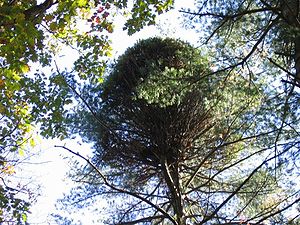
Witch's broom
Encyclopedia


Woody plant
A woody plant is a plant that uses wood as its structural tissue. These are typically perennial plants whose stems and larger roots are reinforced with wood produced adjacent to the vascular tissues. The main stem, larger branches, and roots of these plants are usually covered by a layer of...
, typically a tree
Tree
A tree is a perennial woody plant. It is most often defined as a woody plant that has many secondary branches supported clear of the ground on a single main stem or trunk with clear apical dominance. A minimum height specification at maturity is cited by some authors, varying from 3 m to...
, where the natural structure of the plant is changed. A dense mass of shoot
Shoot
Shoots are new plant growth, they can include stems, flowering stems with flower buds, and leaves. The new growth from seed germination that grows upward is a shoot where leaves will develop...
s grows from a single point, with the resulting structure resembling a broom or a bird's nest
Nest
A nest is a place of refuge to hold an animal's eggs or provide a place to live or raise offspring. They are usually made of some organic material such as twigs, grass, and leaves; or may simply be a depression in the ground, or a hole in a tree, rock or building...
.
One example of this would be cytokinin
Cytokinin
Cytokinins are a class of plant growth substances that promote cell division, or cytokinesis, in plant roots and shoots. They are involved primarily in cell growth and differentiation, but also affect apical dominance, axillary bud growth, and leaf senescence...
, a phytohormone, interfering with an auxin-regulated bud. Usually auxin
Auxin
Auxins are a class of plant hormones with some morphogen-like characteristics. Auxins have a cardinal role in coordination of many growth and behavioral processes in the plant's life cycle and are essential for plant body development. Auxins and their role in plant growth were first described by...
would keep the secondary, tertiary, and so on apexes from growing too much, but cytokinin releases them from this control, causing these apexes to grow into witch's brooms.
Witch's broom growths last for many years and can be caused by many different types of organisms, such as fungi
Fungus
A fungus is a member of a large group of eukaryotic organisms that includes microorganisms such as yeasts and molds , as well as the more familiar mushrooms. These organisms are classified as a kingdom, Fungi, which is separate from plants, animals, and bacteria...
, oomycetes, insect
Insect
Insects are a class of living creatures within the arthropods that have a chitinous exoskeleton, a three-part body , three pairs of jointed legs, compound eyes, and two antennae...
s, mistletoe
Mistletoe
Mistletoe is the common name for obligate hemi-parasitic plants in several families in the order Santalales. The plants in question grow attached to and within the branches of a tree or shrub.-Mistletoe in the genus Viscum:...
, dwarf mistletoes, mite
Mite
Mites, along with ticks, are small arthropods belonging to the subclass Acari and the class Arachnida. The scientific discipline devoted to the study of ticks and mites is called acarology.-Diversity and systematics:...
s, nematode
Nematode
The nematodes or roundworms are the most diverse phylum of pseudocoelomates, and one of the most diverse of all animals. Nematode species are very difficult to distinguish; over 28,000 have been described, of which over 16,000 are parasitic. It has been estimated that the total number of nematode...
s, phytoplasma
Phytoplasma
Phytoplasma are specialised bacteria that are obligate parasites of plant phloem tissue and transmitting insects . They were first discovered by scientists in 1967 and were named mycoplasma-like organisms or MLOs. They cannot be cultured in vitro in cell-free media...
s and virus
Virus
A virus is a small infectious agent that can replicate only inside the living cells of organisms. Viruses infect all types of organisms, from animals and plants to bacteria and archaea...
es. Human activity is sometimes behind the introduction of these organisms; for example when a person prunes a tree improperly, leaving the tree susceptible to disease.
Witch's brooms occasionally result in desirable changes. Some cultivars of trees, such as Picea orientalis 'Tom Thumb Gold', were discovered as witch's brooms. If twigs of witches' brooms are grafted onto normal rootstocks, freak trees result, showing that the attacking organism has changed the inherited growth pattern of the twigs.
Witch's brooms are used by various animals for nesting including the northern flying squirrel
Northern Flying Squirrel
The Northern flying squirrel is one of two species of the genus Glaucomys, the only flying squirrels found in North America . Unlike most members of their family, flying squirrels are strictly nocturnal...
See also
- Witch's Broom Nebula
- Moniliophthora perniciosaMoniliophthora perniciosaMoniliophthora perniciosa is a fungus that causes "Witches' Broom Disease" of the cocoa tree...
, cause of Witch's broom disease in cacao - Epicormic shootEpicormic shootAn epicormic shoot is a shoot growing from an epicormic bud which lies underneath the bark of a trunk, stem, or branch of a plant.-Epicormic buds:...
, shoots that develop from buds under the bark - Adventitiousness, shoots that develop in unusual places
External links
- Witches' Broom links to an article about witches' brooms on the BBC h2g2 website.

